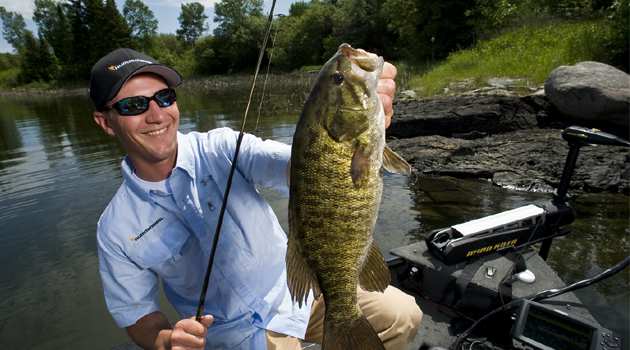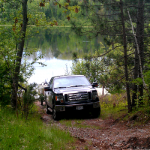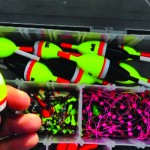Like the weather‐beaten parchment of some maritime legend, the map of Rainy Lake should read “Here Be Dragons.” Straddling the border between Minnesota and Ontario, Rainy is a multi‐species playground teeming with monsters: fat walleyes, giant crappies, big pike and linebacker smallmouth bass. With an expansive 220,000 acres of world‐class fishing, it should be on every angler’s bucket list.It’s also home to one of the most prestigious open team bass tournaments in North America, the Fort Frances Canadian Bass Championship (FFCBC), an annual three‐day event that draws the continent’s best bass anglers in a veritable treasure hunt for the lake’s biggest bronzebacks.
Held this past weekend, July 25‐27, the weather was as fierce as the competition. A hundred teams plied calm waters on Day One but rode out Day Two and Three in cold‐front conditions, culminating in a more than ten degree drop in water temperature and northerly gusts reaching 40 mph.
Not typically the kind of conditions for filling bags with big bass; yet, for many competitors the bite was excellent.
Case in point, 2013 FFCBC champs Jeff “Gussy” Gustafson and John Peterson, who weighed an impressive 55.42 pounds over the three‐day tournament, finished first after five consecutive years in the top ten, including three third place spots.
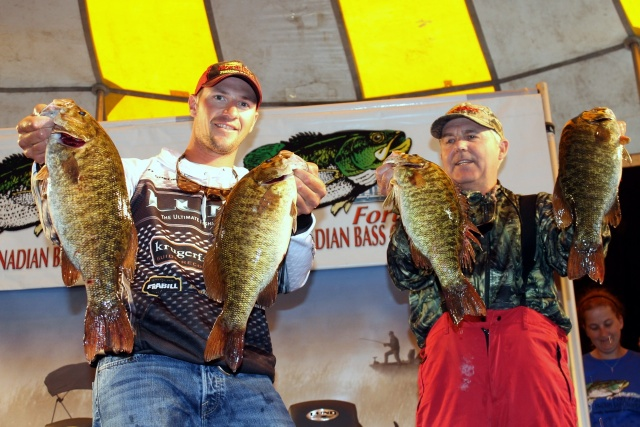
“Rainy is one of my faves—lots of water and big fish,” said Gustafson.
We’ve been close to first place a number of times since JP and I teamed up in 2007, but like any big water tournament a lot of things have to go your way to win it.”
Northland Tackle’s John Peterson agreed. “Seems like the stars have to line up to win the FFCBC. But this year, on Day One we had nearly 20 pounds and Gussy boated a 4.72—the biggest fish of Day One— that really anchored us.”
Ultimately, though, it’s the result of a lot of hard work by the multi‐generational team, who’ve spent the past ten years scrutinizing Rainy Lake’s smallmouth bass habitat.
“It’s not just about finding and catching the right fish, it’s about traversing a giant body of water and getting back home in adverse conditions. Rainy can beat the snot out of you. We’ve been adding to our game plan every year, which is a big confidence factor,” said Peterson.
For Gussy and JP that confidence boost is partly due to stringing together a trap line of high‐probability waypoints, many in the southern part of the lake, where they’ve taken to hunting larger, lone wolf fish on isolated structure.
“The new LakeMaster Version 4 Woods/Rainy card has a lot more detail than Version 3, which really paid off for us. Helped me find nearly a dozen little humps and shoals that held fish I never even knew were there, even though I’d fished the area seven or eight years,” said Gustafson.
Once high‐probability spots were identified during pre‐fishing, Gustafson used Side Imaging to find the hard bottom corners with surrounding weeds. He’d then create waypoints to allow casting to the structure from a distance to avoid blowing out the fish.
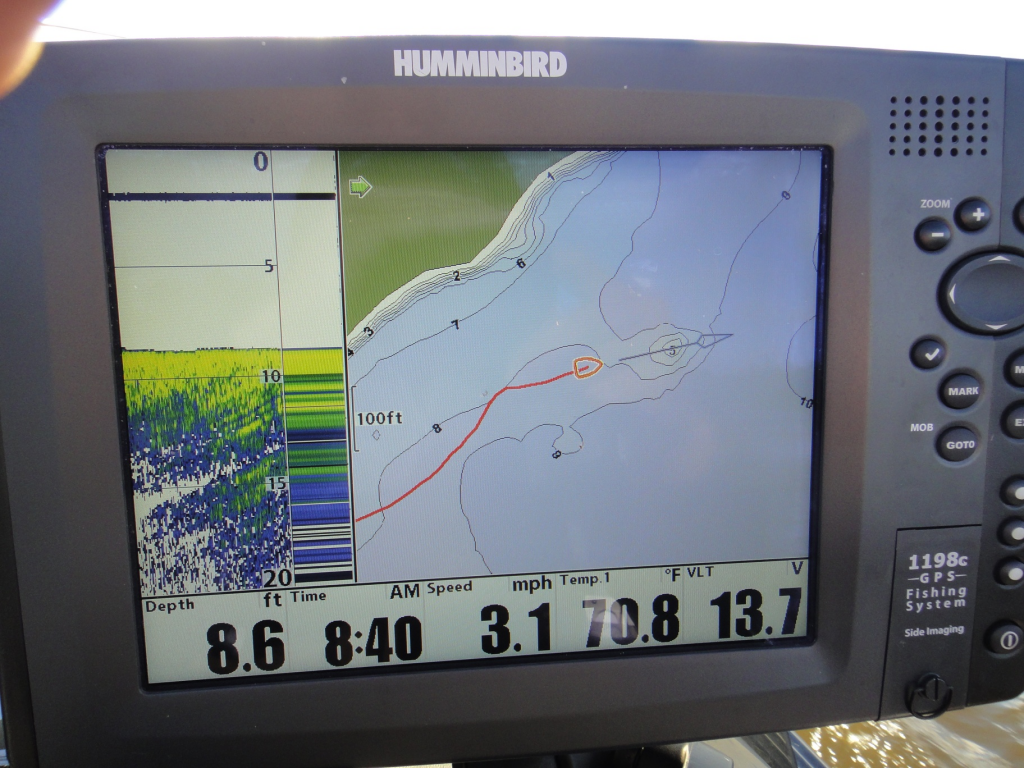
“Especially for this year’s shallow‐water game, the Humminbird 958 on my bow was set to full‐screen GPS. Once the tournament started, we were fishing solely to what we saw on the map,” Gustafson reported.
Yet, rather than burn waypoints right away, they spent their time finding new fish the first two days of the tournament, still relying almost entirely on the lake map to locate new spots.
“We found a couple new areas that ended up being pretty key in the tournament. By 8:30 am on Day One we had 18 pounds without touching any of our high‐profile spots, almost every fish on a Jackall popper.”
At the end of Day One, Gussy and JP climbed into first with an impressive 19.17 pounds.
DAY TWO
Although they hoped for a repeat of Day One, Day Two greeted competitors with increasing north winds and falling temps. “The conditions were definitely more challenging. By 11 am we only had three fish. We pulled into an area and caught three pretty good fish on ½‐ounce white and yellow Northland Reed Runner spinnerbaits – and ended up getting a few more upgrades, but it was difficult. We finished at 15.90 pounds, which dropped us into fourth place.”
DAY THREE
The weather only worsened on Day Three, furrowing the brows of competitors, particularly Gussy and JP, who had leaderboard space to climb.
“My buddies Jay Samsal and Troy Norman were in first going into Day Three, but only by a pound and change. Still, we were a little bit worried with the falling water temps and severe winds. So we planned to start dialing in our saved waypoints on the Humminbird.”
Gussy and JP could almost see the whites of their competitors’ eyes as they began Day 3 fishing a mere 300 yards from Samsal and Norman.
“We started on a point where we caught some of the better fish on Day Two and discovered pretty quick that this was no normal cold front situation. Although it was super windy, we ended up catching four big fish and a two‐and‐a‐half pounder in the first half hour and then started upgrading the rest of the day.”
Added Peterson: “We found a school of big ones, which isn’t always easy. Normally, we’re picking one fish off a sweet spot here, a sweet spot there. Bass holding on an inside turn, a weedy area with boulders in a bay or a wind‐blown shore or an isolated hump with the same stuff.”
“But we got into got into this little area where the fish were really hot for spinnerbaits. Just proves that you can have all the preconceived notions you want but the fish will bite where and what they want, we just needed to capitalize on it. My twin Minn Kota Talon shallow‐water anchors kept us right on target, even in the extreme winds, so we could keep our baits right in the strike zone,” said Gustafson.
Their money spot was just one of 40 or 50 waypoints on the Gustafson’s Humminbird 1198, many of which were just the right combination of weeds and rock in water less than 10 feet with deeper water nearby.
With 19 pounds in the livewell that quickly, Peterson says Day Three was a thrilling final chapter to “a day from heaven and the day from hell.”
“It was blowing so bad you couldn’t distinguish bites on jigs or tubes, so we had to resort to power fishing spinnerbaits. Given the cold front conditions, we weren’t sure if it’d work, but it did. I think the water was so warm earlier this season that the drop from the high 70s to mid 60s actually helped the bite.”
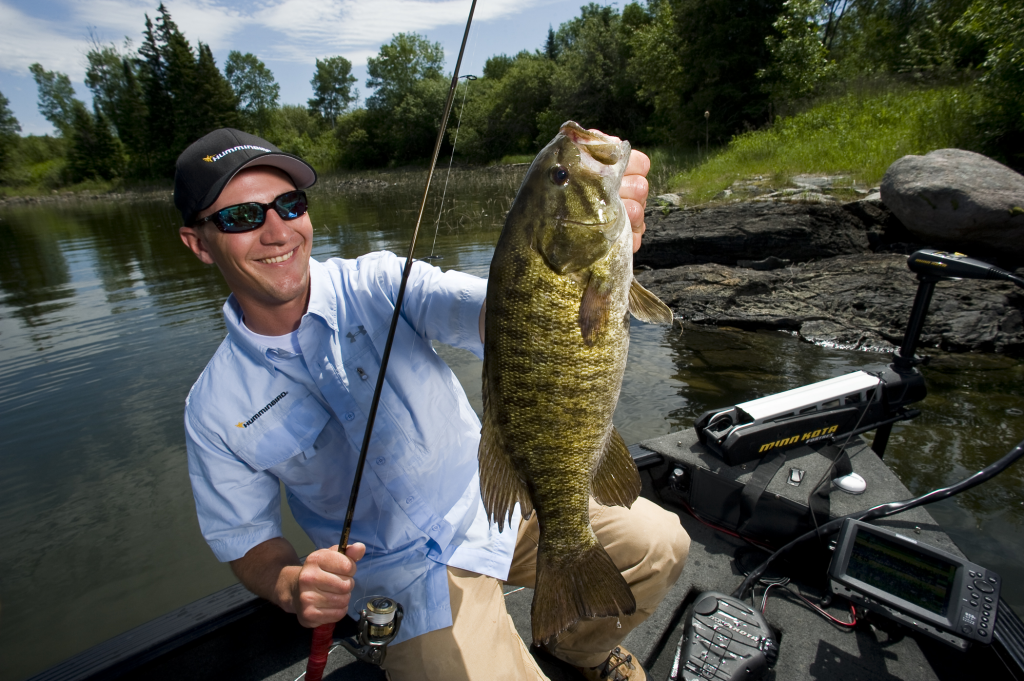
Peterson says normally the FFCBD is won with finesse baits, but this year was all about power fishing. “It’s just what the fish wanted. We covered a lot of water looking for biters—and the fish that hit spinnerbaits just about tore your arm off. We didn’t have to baby any of them.”
Peterson laughs when he says the first two days of the tournament neither of them lost a fish. It wasn’t until looking for those final upgrades on Day 3 that Murphy’s Law took effect.
“To be honest, while we were looking for a kicker we lost six big fish in a row. Of course, then doubt sets in—that you lose big fish in a tournament and you don’t win. But we had a bunch of wild jumpers that came unbuttoned and spit the hook. Likewise, we lost a fish close to 5 pounds a foot from the net. And we had problems with fluoro breaking. I’m convinced if we could have upgraded with half of those we lost, we would’ve come in with 22 pounds. It was probably the best day of smallmouth fishing I’ve ever had—all in the middle of a cold front.”
Along the way, Gustafson switched rods from a stiffer 7’2” to a 7’6” with a softer tip, and also substituted his Shimano Chronarch reel’s fluoro for 30‐pound PowerPro braid.
“The longer crankbait rod allowed me to make longer casts and it’s softer tip made it possible to fish the heavy braid without ripping the hooks out of potential upgrades,” said Gustafson.
All said and done—Murphy’s Law defeated—the Kenora/Bemidji duo ended up with a 20.35‐pound bag, enough to raise their confidence to where they thought they might have a shot at first place once back at the weigh‐in.
Gustafson: “Anybody who’s been on Rainy knows that it’s big water with a lot of open stretches. Day Three made it uncomfortable for a lot of guys out there. But we were fortunate that we had a pretty good bag and didn’t have to run home at the last minute.”
Also the first pro bass competitor in recent memory to fish the FLW pro bass circuit in an aluminum V‐hull boat, Gustafson says the FFCBC is a good example of how the hull of his Lund Predator 2010 eliminates one of the greatest stresses of big‐water tournaments.
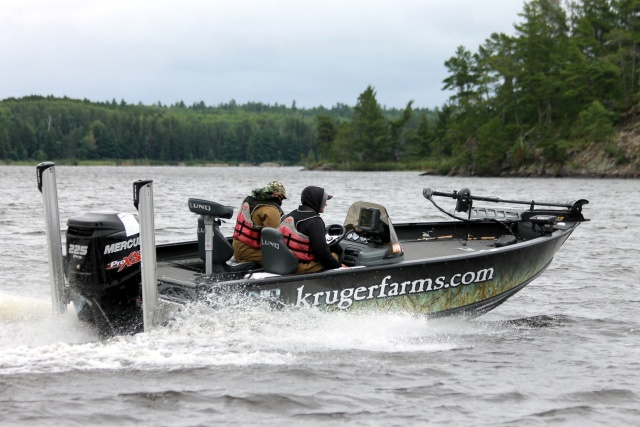
“We made it home without any problems – the boat isn’t real heavy and the hull design makes it possible to ride pretty high on big waves. Plus, fish were healthy in that big livewell. For guys who fish the Great Lakes it’s a dream smallmouth boat in big water. It’s not a big tank, rides comfortable, and gets the job done.”
Finishing a pound and three quarters above the second place team of Ryan Hyatt and Karl Wolff, Jeff Gustafson and John Peterson left Fort Frances with the rewards of a decade’s worth of hard work. Sure, they made a little money, but the team says the gorgeous trophy and respect from their peers far outweighs any monetary sum.


